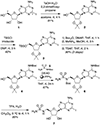Design and synthesis of a library of C2-substituted sulfamidoadenosines to probe bacterial permeability
- PMID: 37734424
- PMCID: PMC10842738
- DOI: 10.1016/j.bmcl.2023.129486
Design and synthesis of a library of C2-substituted sulfamidoadenosines to probe bacterial permeability
Abstract
Antibiotic resistance is a major threat to public health, and Gram-negative bacteria pose a particular challenge due to their combination of a low permeability cell envelope and efflux pumps. Our limited understanding of the chemical rules for overcoming these barriers represents a major obstacle in antibacterial drug discovery. Several recent efforts to address this problem have involved screening compound libraries for accumulation in bacteria in order to understand the structural properties required for Gram-negative permeability. Toward this end, we used cheminformatic analysis to design a library of sulfamidoadenosines (AMSN) having diverse substituents at the adenine C2 position. An efficient synthetic route was developed with installation of a uniform cross-coupling reagent set using Sonogashira and Suzuki reactions of a C2-iodide. The potential utility of these compounds was demonstrated by pilot analysis of selected analogues for accumulation in Escherichia coli.
Keywords: Antibiotic resistance; Diversity-oriented synthesis; Drug discovery; Gram-negative bacteria; Nucleoside analogue.
Copyright © 2023 Elsevier Ltd. All rights reserved.
Conflict of interest statement
Declaration of Competing Interest S.Z. is a current employee of Merck & Co. B.S.S. is a former employee of Merck & Co. D.S.T. has received in-kind research support from Merck & Co. as a collaborating institution on this project and, in the last 3 years, has held equity interests in Merck & Co.
Figures







References
-
- CDC, “Antibiotic Resistance Threats in the United States, 2019,” Centers for Disease Control and Prevention, 2019; https://www.cdc.gov/drugresistance/biggest-threats.html
-
- WHO, “Antimicrobial resistance: Global report on surveillance 2014,” World Health Organization, 2014; http://www.who.int/drugresistance/documents/surveillancereport/en/
-
- Pew, “A Scientific Roadmap for Antibiotic Discovery,” The Pew Charitable Trusts, 2016; https://www.pewtrusts.org/en/research-and-analysis/reports/2016/05/a-sci...
Publication types
MeSH terms
Substances
Grants and funding
LinkOut - more resources
Full Text Sources
Medical
Miscellaneous

